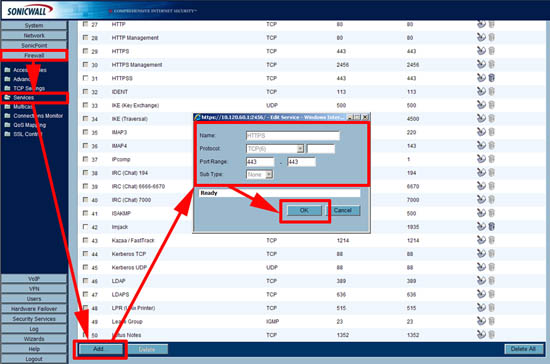
If you're using Exchange, see Receive connectors for more information. This connector must recognize the right certificate when Microsoft 365 or Office 365 attempts a connection with your server.
#Sonicwall port forwarding wizard update
If you want to use certificates for secure communication between Microsoft 365 or Office 365 and your email server, update the connector your email server uses to receive mail. Buy a CA-signed digital certificate that matches this description, if necessary. We recommend that the certificate subject name includes the domain name that matches the primary email server in your organization. Follow these steps:Įnsure that your on-premises email server is set up and capable of sending and receiving Internet (external) email.Ĭheck that your on-premises email server has Transport Layer Security (TLS) enabled, with a valid certification authority-signed (CA-signed) certificate. Prepare your on-premises email server so that it's ready to connect with Microsoft 365 or Office 365. Prerequisites for your on-premises email environment

To complete the scenario, you might need to configure your email server to send messages to Microsoft 365 or Office 365. When your email server sends all email messages directly to Microsoft 365 or Office 365, your own IP addresses are shielded from being added to a spam-block list.

This connector enables Microsoft 365 or Office 365 to scan your email for spam and malware, and to enforce compliance requirements such as running data loss prevention policies. To complete this scenario, you'll also need to configure your email server to send email messages directly to Microsoft 365 or Office 365. This recipient could be a mailbox for your organization in Microsoft 365 or Office 365, or it could be a recipient on the internet. When this connector is set up, Microsoft 365 or Office 365 accepts messages from your organization's email server and send the messages to recipients on your behalf. To complete the scenario, you might need to configure your email server to accept messages delivered by Microsoft 365 or Office 365.Ī connector from your own email server to Office 365 To prepare for this mail delivery scenario, you must set up an alternative server (called a "smart host") so that Microsoft 365 or Office 365 can send emails to your organization's email server (also called "on-premises server"). When you set up Microsoft 365 or Office 365 to accept all emails on behalf of your organization, you will point your domain's MX (mail exchange) record to Microsoft 365 or Office 365.

How do connectors route mail between Microsoft 365 or Office 365 and my own email server? Without connectors, email will not flow between Microsoft 365 or Office 365 and your organization's email servers. If you have your own email servers and Microsoft 365 or Office 365, you must set up connectors in Microsoft 365 or Office 365.

How do connectors work with my on-premises email servers? To learn more about partner scenarios, see Set up connectors for secure mail flow with a partner organization. If you apply the steps described in this article to partner email services, you may have unintended consequences including email delivery failure. Before you get started, make sure to check on your specific scenario in I have my own email servers.


 0 kommentar(er)
0 kommentar(er)
